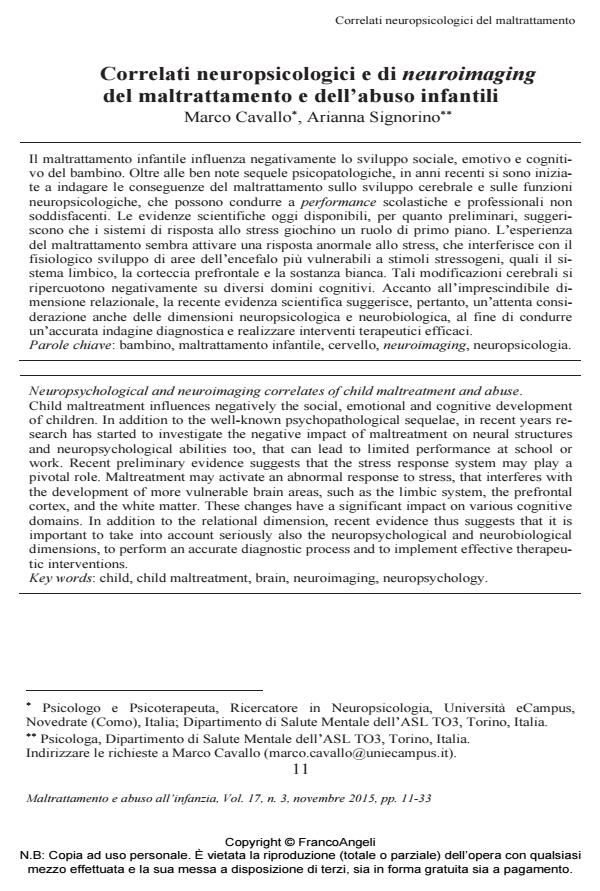Correlati neuropsicologici e di neuroimaging del maltrattamento e dell’abuso infantili
Titolo Rivista MALTRATTAMENTO E ABUSO ALL’INFANZIA
Autori/Curatori Marco Cavallo, Arianna Signorino
Anno di pubblicazione 2015 Fascicolo 2015/3
Lingua Italiano Numero pagine 23 P. 11-33 Dimensione file 130 KB
DOI 10.3280/MAL2015-003002
Il DOI è il codice a barre della proprietà intellettuale: per saperne di più
clicca qui
Qui sotto puoi vedere in anteprima la prima pagina di questo articolo.
Se questo articolo ti interessa, lo puoi acquistare (e scaricare in formato pdf) seguendo le facili indicazioni per acquistare il download credit. Acquista Download Credits per scaricare questo Articolo in formato PDF

FrancoAngeli è membro della Publishers International Linking Association, Inc (PILA)associazione indipendente e non profit per facilitare (attraverso i servizi tecnologici implementati da CrossRef.org) l’accesso degli studiosi ai contenuti digitali nelle pubblicazioni professionali e scientifiche
Il maltrattamento infantile influenza negativamente lo sviluppo sociale, emotivo e cognitivo del bambino. Oltre alle ben note sequele psicopatologiche, in anni recenti si sono iniziate a indagare le conseguenze del maltrattamento sullo sviluppo cerebrale e sulle funzioni neuropsicologiche, che possono condurre a performance scolastiche e professionali non soddisfacenti. Le evidenze scientifiche oggi disponibili, per quanto preliminari, suggeriscono che i sistemi di risposta allo stress giochino un ruolo di primo piano. L’esperienza del maltrattamento sembra attivare una risposta anormale allo stress, che interferisce con il fisiologico sviluppo di aree dell’encefalo più vulnerabili a stimoli stressogeni, quali il sistema limbico, la corteccia prefrontale e la sostanza bianca. Tali modificazioni cerebrali si ripercuotono negativamente su diversi domini cognitivi. Accanto all’imprescindibile dimensione relazionale, la recente evidenza scientifica suggerisce, pertanto, un’attenta considerazione anche delle dimensioni neuropsicologica e neurobiologica, al fine di condurre un’accurata indagine diagnostica e realizzare interventi terapeutici efficaci.
Parole chiave:Bambino, maltrattamento infantile, cervello, neuroimaging, neuropsicologia
- Le memorie traumatiche e il corpo: uno studio su maltrattamento infantile, consapevolezza interocettiva e sintomi somatici Luana La Marca, Andrea Scalabrini, Clara Mucci, Adriano Schimmenti, in MALTRATTAMENTO E ABUSO ALL'INFANZIA 3/2018 pp.47
DOI: 10.3280/MAL2018-003004 - L'assessment psicodiagnostico di bambini vittime di Adverse Childood Experience (ACE): discussione di un caso clinico Daniela D’Elia, Annamaria Scapicchio, Marta Sisto, in MALTRATTAMENTO E ABUSO ALL'INFANZIA 3/2019 pp.75
DOI: 10.3280/MAL2019-003006 - Abuse, emotion regulation, and interoception: What can studies on the brain-body interaction tell us? Laura Angioletti, Michela Balconi, in MALTRATTAMENTO E ABUSO ALL'INFANZIA 1/2020 pp.9
DOI: 10.3280/MAL2020-001002
Marco Cavallo, Arianna Signorino, Correlati neuropsicologici e di neuroimaging del maltrattamento e dell’abuso infantili in "MALTRATTAMENTO E ABUSO ALL’INFANZIA" 3/2015, pp 11-33, DOI: 10.3280/MAL2015-003002